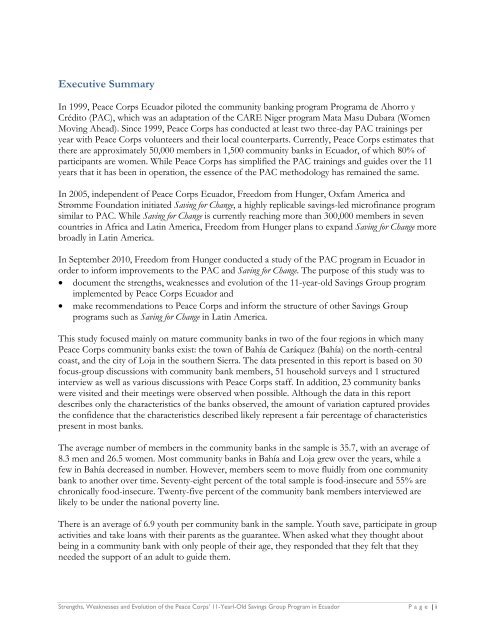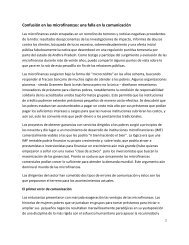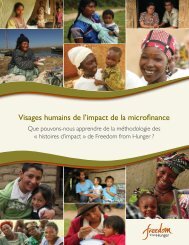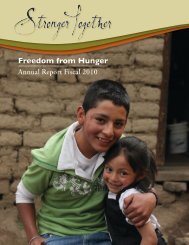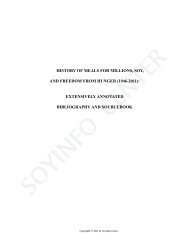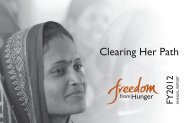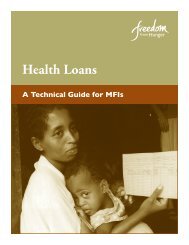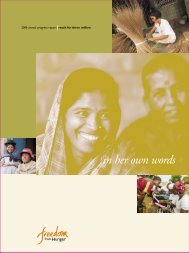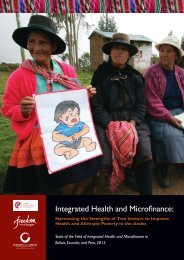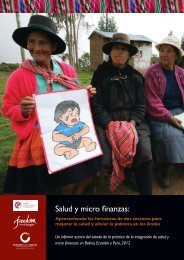Strengths, Weaknesses and Evolution of the Peace Corps' 11-Year ...
Strengths, Weaknesses and Evolution of the Peace Corps' 11-Year ...
Strengths, Weaknesses and Evolution of the Peace Corps' 11-Year ...
You also want an ePaper? Increase the reach of your titles
YUMPU automatically turns print PDFs into web optimized ePapers that Google loves.
Executive Summary<br />
In 1999, <strong>Peace</strong> Corps Ecuador piloted <strong>the</strong> community banking program Programa de Ahorro y<br />
Crédito (PAC), which was an adaptation <strong>of</strong> <strong>the</strong> CARE Niger program Mata Masu Dubara (Women<br />
Moving Ahead). Since 1999, <strong>Peace</strong> Corps has conducted at least two three-day PAC trainings per<br />
year with <strong>Peace</strong> Corps volunteers <strong>and</strong> <strong>the</strong>ir local counterparts. Currently, <strong>Peace</strong> Corps estimates that<br />
<strong>the</strong>re are approximately 50,000 members in 1,500 community banks in Ecuador, <strong>of</strong> which 80% <strong>of</strong><br />
participants are women. While <strong>Peace</strong> Corps has simplified <strong>the</strong> PAC trainings <strong>and</strong> guides over <strong>the</strong> <strong>11</strong><br />
years that it has been in operation, <strong>the</strong> essence <strong>of</strong> <strong>the</strong> PAC methodology has remained <strong>the</strong> same.<br />
In 2005, independent <strong>of</strong> <strong>Peace</strong> Corps Ecuador, Freedom from Hunger, Oxfam America <strong>and</strong><br />
Strømme Foundation initiated Saving for Change, a highly replicable savings-led micr<strong>of</strong>inance program<br />
similar to PAC. While Saving for Change is currently reaching more than 300,000 members in seven<br />
countries in Africa <strong>and</strong> Latin America, Freedom from Hunger plans to exp<strong>and</strong> Saving for Change more<br />
broadly in Latin America.<br />
In September 2010, Freedom from Hunger conducted a study <strong>of</strong> <strong>the</strong> PAC program in Ecuador in<br />
order to inform improvements to <strong>the</strong> PAC <strong>and</strong> Saving for Change. The purpose <strong>of</strong> this study was to<br />
document <strong>the</strong> strengths, weaknesses <strong>and</strong> evolution <strong>of</strong> <strong>the</strong> <strong>11</strong>-year-old Savings Group program<br />
implemented by <strong>Peace</strong> Corps Ecuador <strong>and</strong><br />
make recommendations to <strong>Peace</strong> Corps <strong>and</strong> inform <strong>the</strong> structure <strong>of</strong> o<strong>the</strong>r Savings Group<br />
programs such as Saving for Change in Latin America.<br />
This study focused mainly on mature community banks in two <strong>of</strong> <strong>the</strong> four regions in which many<br />
<strong>Peace</strong> Corps community banks exist: <strong>the</strong> town <strong>of</strong> Bahía de Caráquez (Bahía) on <strong>the</strong> north-central<br />
coast, <strong>and</strong> <strong>the</strong> city <strong>of</strong> Loja in <strong>the</strong> sou<strong>the</strong>rn Sierra. The data presented in this report is based on 30<br />
focus-group discussions with community bank members, 51 household surveys <strong>and</strong> 1 structured<br />
interview as well as various discussions with <strong>Peace</strong> Corps staff. In addition, 23 community banks<br />
were visited <strong>and</strong> <strong>the</strong>ir meetings were observed when possible. Although <strong>the</strong> data in this report<br />
describes only <strong>the</strong> characteristics <strong>of</strong> <strong>the</strong> banks observed, <strong>the</strong> amount <strong>of</strong> variation captured provides<br />
<strong>the</strong> confidence that <strong>the</strong> characteristics described likely represent a fair percentage <strong>of</strong> characteristics<br />
present in most banks.<br />
The average number <strong>of</strong> members in <strong>the</strong> community banks in <strong>the</strong> sample is 35.7, with an average <strong>of</strong><br />
8.3 men <strong>and</strong> 26.5 women. Most community banks in Bahía <strong>and</strong> Loja grew over <strong>the</strong> years, while a<br />
few in Bahía decreased in number. However, members seem to move fluidly from one community<br />
bank to ano<strong>the</strong>r over time. Seventy-eight percent <strong>of</strong> <strong>the</strong> total sample is food-insecure <strong>and</strong> 55% are<br />
chronically food-insecure. Twenty-five percent <strong>of</strong> <strong>the</strong> community bank members interviewed are<br />
likely to be under <strong>the</strong> national poverty line.<br />
There is an average <strong>of</strong> 6.9 youth per community bank in <strong>the</strong> sample. Youth save, participate in group<br />
activities <strong>and</strong> take loans with <strong>the</strong>ir parents as <strong>the</strong> guarantee. When asked what <strong>the</strong>y thought about<br />
being in a community bank with only people <strong>of</strong> <strong>the</strong>ir age, <strong>the</strong>y responded that <strong>the</strong>y felt that <strong>the</strong>y<br />
needed <strong>the</strong> support <strong>of</strong> an adult to guide <strong>the</strong>m.<br />
<strong>Strengths</strong>, <strong>Weaknesses</strong> <strong>and</strong> <strong>Evolution</strong> <strong>of</strong> <strong>the</strong> <strong>Peace</strong> Corps’ <strong>11</strong>-<strong>Year</strong>l-Old Savings Group Program in Ecuador P a g e | i


